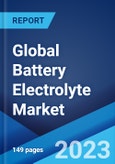The global battery electrolyte market size reached US$ 9.3 Billion in 2022. Looking forward, the market is expected to reach US$ 14.6 Billion by 2028, exhibiting a growth rate (CAGR) of 7.81% during 2022-2028.
Electrolytes are liquid or paste-like substances that transport positively charged ions between the cathode and anode terminals inside batteries to produce electricity. Their different chemical compounds find application depending on the type of battery. For instance, lead-acid batteries use sulfuric acid to create the intended reaction, while household alkaline batteries contain potassium hydroxide as electrolytes. Similarly, zinc-air batteries rely on oxidizing zinc with oxygen and lithium batteries have lithium salt solution, such as lithium hexafluorophosphate (LiPF6).
Electrolytes are liquid or paste-like substances that transport positively charged ions between the cathode and anode terminals inside batteries to produce electricity. Their different chemical compounds find application depending on the type of battery. For instance, lead-acid batteries use sulfuric acid to create the intended reaction, while household alkaline batteries contain potassium hydroxide as electrolytes. Similarly, zinc-air batteries rely on oxidizing zinc with oxygen and lithium batteries have lithium salt solution, such as lithium hexafluorophosphate (LiPF6).
Battery Electrolyte Market Trends
The emerging trend of high-end consumer electronics, such as smartphones, laptops, digital cameras, gaming consoles, and torches, represents one of the major factors driving the demand for electrolyte-based lithium-ion batteries worldwide. Moreover, the escalating demand for electric vehicles (EVs) on account of the growing focus on sustainable development and the awareness about the adverse effects of using petroleum-based automobiles is impelling the market growth. Additionally, governing agencies of numerous countries are offering subsidies and implementing favorable initiatives to promote the adoption of EVs, which, in turn, is contributing to market growth. Apart from this, increasing sales of vacuum cleaners due to sedentary lifestyles, hectic working schedules, inflating income levels, and rapid urbanization are driving the sales of battery electrolytes around the world. This can also be accredited to the growing popularity of smart homes and the rising demand for automated products that can perform household activities in a time-efficient manner. Furthermore, the application of battery electrolytes is expanding in the manufacturing of alkaline zinc-manganese oxide batteries. As a result, the escalating demand for these batteries in still digital cameras, portable liquid crystal televisions (TVs), shavers, office-use appliances, and game equipment is anticipated to drive the market.Key Market Segmentation
This research provides an analysis of the key trends in each sub-segment of the global battery electrolyte market report, along with forecasts at the global, regional and country level from 2023-2028. The report has categorized the market based on battery type, electrolyte type and end user.Breakup by Battery Type:
- Lead Acid
- Lithium-ion
- Flow Battery
Breakup by Electrolyte Type:
- Liquid Electrolyte
- Solid Electrolyte
- Gel Electrolyte
- Sodium Chloride
- Nitric Acid
- Sulphuric Acid
Breakup by End User:
- Electric Vehicle
- Energy Storage
- Consumer Electronics
Breakup by Region:
- North America
- United States
- Canada
- Asia-Pacific
- China
- Japan
- India
- South Korea
- Australia
- Indonesia
- Europe
- Germany
- France
- United Kingdom
- Italy
- Spain
- Russia
- Latin America
- Brazil
- Mexico
- Middle East and Africa
Competitive Landscape
The competitive landscape of the industry has also been examined along with the profiles of the key players being 3M Company, American Elements, BASF SE, GS Yuasa International Ltd., Guangzhou Tinci Materials Technology Co. Ltd., Johnson Controls, LG Chem Ltd., Mitsubishi Chemical Corporation, Mitsui Chemicals Inc., Shenzhen Capchem Technology Co. Ltd., Targray and Ube Industries Ltd.Key Questions Answered in This Report:
- How has the global battery electrolyte market performed so far and how will it perform in the coming years?
- What has been the impact of COVID-19 on the global battery electrolyte market?
- What are the key regional markets?
- What is the breakup of the market based on the battery type?
- What is the breakup of the market based on the electrolyte type?
- What is the breakup of the market based on the end user?
- What are the various stages in the value chain of the industry?
- What are the key driving factors and challenges in the industry?
- What is the structure of the global battery electrolyte market and who are the key players?
- What is the degree of competition in the industry?
Table of Contents
1 Preface3 Executive Summary11 Value Chain Analysis13 Price Analysis
2 Scope and Methodology
4 Introduction
5 Global Battery Electrolyte Market
6 Market Breakup by Battery Type
7 Market Breakup by Electrolyte Type
8 Market Breakup by End User
9 Market Breakup by Region
10 SWOT Analysis
12 Porters Five Forces Analysis
14 Competitive Landscape
Companies Mentioned
- 3M Company
- American Elements
- BASF SE
- GS Yuasa International Ltd.
- Guangzhou Tinci Materials Technology Co. Ltd.
- Johnson Controls
- LG Chem Ltd.
- Mitsubishi Chemical Corporation
- Mitsui Chemicals Inc.
- Shenzhen Capchem Technology Co. Ltd.
- Targray
- Ube Industries Ltd.
Methodology

LOADING...
Table Information
| Report Attribute | Details |
|---|---|
| No. of Pages | 149 |
| Published | November 2023 |
| Forecast Period | 2022 - 2028 |
| Estimated Market Value ( USD | $ 9.3 Billion |
| Forecasted Market Value ( USD | $ 14.6 Billion |
| Compound Annual Growth Rate | 7.8% |
| Regions Covered | Global |
| No. of Companies Mentioned | 12 |









